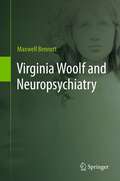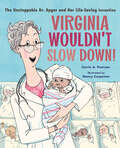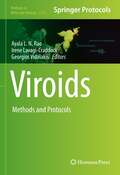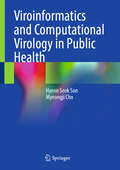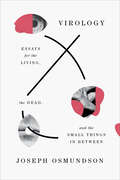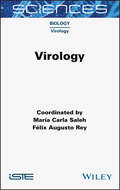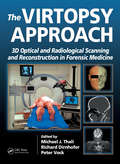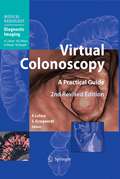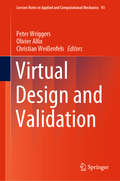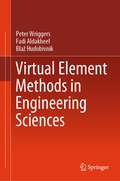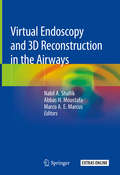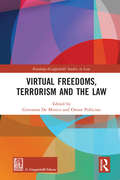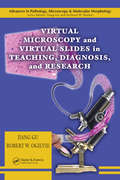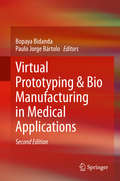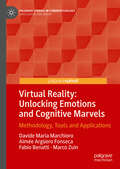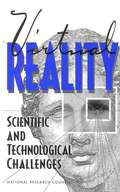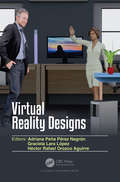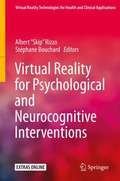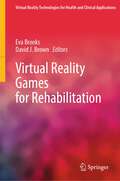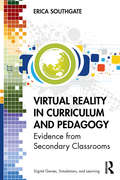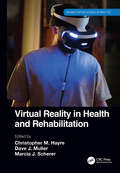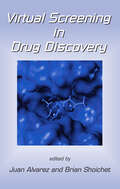- Table View
- List View
Virginia Woolf and Neuropsychiatry
by Maxwell BennettThis book, written by one of the leaders in the field of the neurosciences, will give an explanation of the symptoms and eventual untimely suicide of one of literatures greatest authors; Virginia Woolf. The sources used are letters and statements from Woolf herself, the literature she wrote and comments, letters and any other documentation that referred to her mental state and her medical status. The author will use current insight into depression, the mental consequences of child abuse and drug interactions/effects to illustrate this case study. The book should appeal to researchers in the neurosciences, psychology and psychiatry as well as to a broader audience, mainly individuals who are interested in the (external and internal) forces that drove Woolf to write her material.
Virginia Wouldn't Slow Down!: The Unstoppable Dr. Apgar And Her Life-saving Invention
by Carrie A. PearsonA delightful and distinctive picture book about Dr. Virginia Apgar, who invented the eponymous test for evaluating newborn health that’s used worldwide every day. The Apgar Score is known the world over: a test given to babies to determine their health moments after they are born. Less well-known is the story of the brilliant, pioneering woman who invented it. Born at the turn of the twentieth century, Virginia “Ginny” Apgar soared above what girls were expected to do—or not do. She wasn’t quiet, she wore all sorts of outfits, she played the sports she wanted to—and she pursued the career she chose, graduating near the top of her class at Columbia University and becoming only the second board-certified female anesthesiologist in the United States. The simple five-step test she created—scribbled on the back of a piece of paper in answer to a trainee’s question—became the standard and continues to impact countless newborn babies’ lives today. Ginny adored science, hated cooking, drove fast, made her own violins, earned a pilot’s license, and traveled the world. Here, Carrie Pearson’s jaunty storytelling and Nancy Carpenter’s playful illustrations capture the energy and independence of a woman who didn’t slow down for anything—and changed newborn care forever.
The Virility Paradox: The Vast Influence of Testosterone on Our Bodies, Minds, and the World We Live In
by Charles J. RyanTestosterone makes us stronger, happier, and smarter. It also makes us meaner, more violent and more selfish. A scientific look into the vast and unexpected influence testosterone has on our behavior, our society, and our bodies. The brain of every man—and every woman—is shaped by this tiny molecule from before birth: it propels our drive for exploration and risk, for competition and creation, and even our survival. The effects of testosterone permeate the traditions, philosophy, and literature of every known culture—without it, the world would be a drastically different place. Testosterone also has a role in humanity's darker side, contributing to violence, hubris, poverty, crime, and selfishness. Recent revelations of the science of testosterone show that high levels will deplete compassion and generosity, and even reduce the affection we show our children. In The Virility Paradox, internationally renowned oncologist and prostate cancer researcher Charles Ryan explores this complex chemical system responsible for a diverse spectrum of human behaviors and health in both men and women. Ryan taps his vast experience treating prostate cancer with testosterone-lowering therapy, observing that this often leads to profound changes in the patients' perspectives on their lives and relationships. Often, for the better. Ryan uses the journeys of these patients and others to illustrate the vast and sometimes unexpected influence testosterone has on human lives. Through the stories of real men and women, he also explores the connections between testosterone and conditions like dementia, autism, and cancer, as well as the biological underpinnings of sexual assault and the effects it has on everything from crime to investing to everyday choices we make. Integrating the molecular and the medical, sociology and storytelling, The Virility Paradox;offers a fascinating look at how one hormone has shaped history, and the connections between our biology, our behavior, and our best selves.
Viroids: Methods and Protocols (Methods in Molecular Biology #2316)
by Ayala L. N. Rao Irene Lavagi-Craddock Georgios VidalakisThis volume explores the latest methods used by researchers to study the detection, characterization, and various aspects of viroids. The chapters in this book are organized into seven parts and cover topics such as detection methods based on the biology of viroids; detection techniques based on electrophoresis and hybridization techniques; PCR-based techniques that provide high degrees of sensitivity; emerging area of nucleic acid sequence-based technology; and emerging techniques in viroid research such as RNA silencing, splicing, and viroid structure. Written in the highly successful Methods in Molecular Biology series format, chapters include introductions to their respective topics, lists of the necessary materials and reagents, step-by-step, readily reproducible laboratory protocols, and tips on troubleshooting and avoiding known pitfalls. Cutting-edge and comprehensive, Viroids: Methods and Protocols is a valuable resource for researchers and graduate students who are working with viroid diseases.
Viroinformatics and Computational Virology in Public Health
by Hyeon Seok Son Myeongji ChoThis book is intended as a practical and accessible introduction for those who are new to the field of viral infectious diseases and bioinformatics. It is designed for students, early-career researchers, and anyone looking to explore these topics from the ground up. The book covers basic scientific concepts and provides an overview of the epidemiological aspects of viruses, with a focus on simple analytical methods used to study viruses and viral diseases in the context of public health and computational biology. It introduces fundamental informatics tools for virus research, including software tools and databases, while also covering basic theory, algorithms, and applications in viroinformatics and computational virology. Key topics include the virus life cycle, virus evolution, virus-host interactions, and emerging viral diseases.
Virology: Essays For The Living, The Dead, And The Small Things In Between
by Joseph OsmundsonNamed a Most Anticipated Book of 2022 by Literary Hub A leading microbiologist tackles the scientific and sociopolitical impact of viruses in twelve striking essays. Invisible in the food we eat, the people we kiss, and inside our own bodies, viruses flourish—with the power to shape not only our health, but our social, political, and economic systems. Drawing on his expertise in microbiology, Joseph Osmundson brings readers under the microscope to understand the structure and mechanics of viruses and to examine how viruses like HIV and COVID-19 have redefined daily life. Osmundson’s buoyant prose builds on the work of the activists and thinkers at the forefront of the HIV/AIDS crisis and critical scholars like José Esteban Munoz to navigate the intricacies of risk reduction, draw parallels between queer theory and hard science, and define what it really means to “go viral.” This dazzling multidisciplinary collection offers novel insights on illness, sex, and collective responsibility. Virology is a critical warning, a necessary reflection, and a call for a better future.
Virology
by Maria Carla Saleh Felix Augusto ReyViruses interact with all forms of life and have shaped evolution for 4 billion years. The COVID-19 pandemic highlights the importance of conducting scientific research into viruses to understand the interactions between them and their hosts. Virology is made up of eight chapters, all of which have been written by outstanding female virologists, emphasizing women's fundamental role in all aspects of science. It summarizes our current knowledge about the biology of viruses in general and analyzes the specific features of several ones of medical, veterinary and agricultural importance. Genome replication strategies of different virus families are covered, as well as strategies for survival within their hosts by counteraction of the cellular innate antiviral responses. Attention is also given to viral strategies for efficient dissemination in nature, as well as the evolution of a select group of viruses.
The Virtopsy Approach: 3D Optical and Radiological Scanning and Reconstruction in Forensic Medicine
by Michael J. Thali Richard Dirnhofer Peter VockCharred, badly decomposed, or mummified corpses, as well as those restrictions forced upon coroners by certain religious sects, often make autopsies impossible to perform. In addition, lack of manpower among the personnel charged with performing autopsies frequently creates a backlog of cases in the coroner‘s office. This delay increases the likeli
Virtual Colonoscopy
by Philippe Lefere Albert L. Baert Stefàan GryspeerdtVirtual colonoscopy is a rapidly evolving technique for the detection of tumoral lesions in the colon. It is now accepted by the American Cancer Society as a valuable screening tool for both colorectal cancer and its adenomatous precursor. With contributions from leaders in the field, this book addresses all the important issues relating to virtual colonoscopy. There is a particular focus on practical aspects, such as how to start virtual colonoscopy in a department, the regular preparation, and the correct scanning parameters. Imaging characteristics and pitfalls are considered in detail, with an extensive pictorial review of difficult lesions; the importance of computer-aided diagnosis is also discussed. In this second edition the text has been updated with the latest study results and developments in technology and new illustrations have been included. This book will be invaluable to every radiologist seeking information on how to perform the exciting technique of virtual colonoscopy.
Virtual Design and Validation (Lecture Notes in Applied and Computational Mechanics #93)
by Peter Wriggers Olivier Allix Christian WeißenfelsThis book provides an overview of the experimental characterization of materials and their numerical modeling, as well as the development of new computational methods for virtual design. Its 17 contributions are divided into four main sections: experiments and virtual design, composites, fractures and fatigue, and uncertainty quantification. The first section explores new experimental methods that can be used to more accurately characterize material behavior. Furthermore, it presents a combined experimental and numerical approach to optimizing the properties of a structure, as well as new developments in the field of computational methods for virtual design. In turn, the second section is dedicated to experimental and numerical investigations of composites, with a special focus on the modeling of failure modes and the optimization of these materials. Since fatigue also includes wear due to frictional contact and aging of elastomers, new numerical schemes in the field of crack modeling and fatigue prediction are also discussed. The input parameters of a classical numerical simulation represent mean values of actual observations, though certain deviations arise: to illustrate the uncertainties of parameters used in calculations, the book’s final section presents new and efficient approaches to uncertainty quantification.
Virtual Element Methods in Engineering Sciences
by Peter Wriggers Fadi Aldakheel Blaž HudobivnikThis book provides a comprehensive treatment of the virtual element method (VEM) for engineering applications, focusing on its application in solid mechanics. Starting with a continuum mechanics background, the book establishes the necessary foundation for understanding the subsequent chapters. It then delves into the VEM's Ansatz functions and projection techniques, both for solids and the Poisson equation, which are fundamental to the method. The book explores the virtual element formulation for elasticity problems, offering insights into its advantages and capabilities. Moving beyond elasticity, the VEM is extended to problems in dynamics, enabling the analysis of dynamic systems with accuracy and efficiency. The book also covers the virtual element formulation for finite plasticity, providing a framework for simulating the behavior of materials undergoing plastic deformation. Furthermore, the VEM is applied to thermo-mechanical problems, where it allows for the investigation of coupled thermal and mechanical effects. The book dedicates a significant portion to the virtual elements for fracture processes, presenting techniques to model and analyze fractures in engineering structures. It also addresses contact problems, showcasing the VEM's effectiveness in dealing with contact phenomena. The virtual element method's versatility is further demonstrated through its application in homogenization, offering a means to understand the effective behavior of composite materials and heterogeneous structures. Finally, the book concludes with the virtual elements for beams and plates, exploring their application in these specific structural elements. Throughout the book, the authors emphasize the advantages of the virtual element method over traditional finite element discretization schemes, highlighting its accuracy, flexibility, and computational efficiency in various engineering contexts.
Virtual Endoscopy and 3D Reconstruction in the Airways
by Nabil A. Shallik Abbas H. Moustafa Marco A. E. MarcusThis book is unique in its approach, covering the impact of virtual endoscopy and 3D reconstruction on surgical modalities and perioperative airway options. Airway management is an essential skill that is practiced daily by almost all anesthetists across the world. Most of the anesthesia-related morbidities and mortalities in the perioperative period are associated with respiratory complications, either of airway or pulmonary problems. Thus, the prediction of airway complications in perioperative period has been an active research field for many decades and is a cornerstone of perioperative anesthesia assessment and management.Virtual endoscopy & 3D reconstruction is a novel, reliable and non-invasive airway assessment tool that is able to reconstruct simple CT images to provide a clear view of the airway down to the bronchial trees, and offers the highest possible sensitivity, comparable with fiberoptic endoscopic pictures. This revolutionary tool avoids the hazards of invasive airway assessment by fiber-optic bronchoscopy, like bleeding from airway masses, sedation induced airway collapse and other complications. This book is a valuable resource for anesthesiologists, intensivists, surgeons, radiologists, otolaryngologists, medical students as well as residents in training.
Virtual Freedoms, Terrorism and the Law (Routledge-Giappichelli Studies in Law)
by Giovanna De MinicoThis book examines the risks to freedom of expression, particularly in relation to the internet, as a result of regulation introduced in response to terrorist threats. The work explores the challenges of maintaining security in the fight against traditional terrorism while protecting fundamental freedoms, particularly online freedom of expression. The topics discussed include the clash between freedom of speech and national security; the multijurisdictional nature of the internet and the implications for national sovereignty and transnational legal structures; how to determine legitimate and illegitimate association online; and the implications for privacy and data protection. The book presents a theoretical analysis combined with empirical research to demonstrate the difficulty of combatting internet use by terror organizations or individuals and the range of remedies that might be drawn from national and international law. The work will be essential reading for students, researchers and policy makers in the areas of Constitutional law; Criminal Law, European and International law, Information and Technology law and Security Studies.
Virtual Microscopy and Virtual Slides in Teaching, Diagnosis, and Research (Advances in Pathology, Microscopy, & Molecular Morphology)
by Jiang Gu Robert W. OgilvieDespite a brief history, the technologies of virtual microscopy and virtual slides have captured the imagination of many, especially this current crop of students. Having come of age in the computer and Internet age, this emerging group of technicians and researchers tends to display a distinct preference for virtual slides and virtual microscopes.
Virtual Prototyping & Bio Manufacturing in Medical Applications
by Bopaya Bidanda Paulo Jorge BártoloThe original role of RP was to confirm the shape and feel of concept design, but innovations in RP now allow for the development of sophisticated medical devices such as catheters, stents, drug delivery systems, syringes and cardio-vascular devices, and more. RP has moved beyond medical devices, as surgeons now regularly use RP models to brainstorm strategies for surgeries. This book presents new uses for rapid prototyping in state-of-the-art medical applications.
Virtual Reality: Methodology, Tools and Applications (Palgrave Studies in Cyberpsychology)
by Davide Maria Marchioro Aimée Argüero Fonseca Fabio Benatti Marco ZuinThis book is an invaluable resource for researchers, practitioners, and enthusiasts interested in unraveling the potential and promises of virtual reality, delving into its applications, challenges, and the exciting path that lies ahead. In the age of rapidly advancing technology, the intersection of psychology and virtual reality (VR) has opened doors to a world of unprecedented possibilities. This introduction sets the stage for an exploration of the potential of virtual reality within the field of psychology and its intriguing relationship with cyberpsychology. In this book, the authors aim to utilize the transformative power of VR to enhance our understanding of the human mind and emotions, ultimately contributing to the betterment of psychological science and the human experience. The ability to simulate environments, elicit emotional responses, and assess cognitive functions in a controlled, replicable manner presents a paradigm shift in psychological research and practice.
Virtual Reality: Scientific and Technological Challenges
by National Research Council StaffDespite widespread interest in virtual reality, research and development efforts in synthetic environments (SE)--the field encompassing virtual environments, teleoperation, and hybrids--have remained fragmented.Virtual Reality is the first integrated treatment of the topic, presenting current knowledge along with thought-provoking vignettes about a future where SE is commonplace.This volume discusses all aspects of creating a system that will allow human operators to see, hear, smell, taste, move about, give commands, respond to conditions, and manipulate objects effectively in a real or virtual environment. The committee of computer scientists, engineers, and psychologists on the leading edge of SE development explores the potential applications of SE in the areas of manufacturing, medicine, education, training, scientific visualization, and teleoperation in hazardous environments.The committee also offers recommendations for development of improved SE technology, needed studies of human behavior and evaluation of SE systems, and government policy and infrastructure.
Virtual Reality Church: Pitfalls and Possibilities (Or How to Think Biblically about Church in Your Pajamas, VR Baptisms, Jesus Avatars, and Whatever Else is Coming Next)
by Darrell Bock Jonathan ArmstrongIs Virtual Reality a Biblical Reality?The invention of the printing press catalyzed Martin Luther&’s reformation; radios and televisions delivered Billy Graham&’s gospel proclamations to millions of households. Technological advancements have undoubtedly advanced kingdom work for centuries—but is the same true for the burgeoning technologies of today? As virtual reality becomes increasingly prominent throughout society, churches must assess how to respond thoughtfully and biblically. In Virtual Reality Church, theologians Darrell Bock and Jonathan Armstrong present a systematic reflection on how to faithfully apply virtual reality for ministry purposes. They examine the risks—like compromising the meaning of tangible worship—and opportunities—like safely reaching persecuted churches—of integrating revolutionary technologies into the Christian life. Learn to think critically, theologically, and pastorally about new technologies so that you can faithfully advance the gospel into the future.
Virtual Reality Church: Pitfalls and Possibilities (Or How to Think Biblically about Church in Your Pajamas, VR Baptisms, Jesus Avatars, and Whatever Else is Coming Next)
by Darrell Bock Jonathan ArmstrongIs Virtual Reality a Biblical Reality?The invention of the printing press catalyzed Martin Luther&’s reformation; radios and televisions delivered Billy Graham&’s gospel proclamations to millions of households. Technological advancements have undoubtedly advanced kingdom work for centuries—but is the same true for the burgeoning technologies of today? As virtual reality becomes increasingly prominent throughout society, churches must assess how to respond thoughtfully and biblically. In Virtual Reality Church, theologians Darrell Bock and Jonathan Armstrong present a systematic reflection on how to faithfully apply virtual reality for ministry purposes. They examine the risks—like compromising the meaning of tangible worship—and opportunities—like safely reaching persecuted churches—of integrating revolutionary technologies into the Christian life. Learn to think critically, theologically, and pastorally about new technologies so that you can faithfully advance the gospel into the future.
Virtual Reality Designs
by Adriana Peña Pérez Negrón Graciela Lara López Héctor Rafael Orozco AguirreVirtual Reality is not real life. Instead it is life-like creations using computer-generated scenarios. Human behavior is replicated in virtual scenarios, where every detail is controlled by computers, and in situations that can be repeated under the same conditions. Based on technology and design, the user can experience presence. In the virtual world, users are embodied in avatars that represent them and are the means to interact with the virtual environment. Avatars are graphical models that behave on behalf of the human behind them. The user avatar is a proxy that also backs interaction with others, allowing computer-mediated interactions. Analyses directed to understand people’s perceptions, personal and social behavior in computer mediated interactions, comprise a multidisciplinary area of study that involves, among others, computer science, psychology and sociology. In the last two decades a number of studies supported by Virtual Reality have been conducted to understand human behavior, in some cases the implications of the technology, or to reproduce artificial human behavior. This book presents a collection of studies from recognized researchers in the area.
Virtual Reality for Psychological and Neurocognitive Interventions (Virtual Reality Technologies for Health and Clinical Applications)
by Stéphane Bouchard Albert “Skip” RizzoThis exciting collection tours virtual reality in both its current therapeutic forms and its potential to transform a wide range of medical and mental health-related fields. Extensive findings track the contributions of VR devices, systems, and methods to accurate assessment, evidence-based and client-centered treatment methods, and—as described in a stimulating discussion of virtual patient technologies—innovative clinical training. Immersive digital technologies are shown enhancing opportunities for patients to react to situations, therapists to process patients’ physiological responses, and scientists to have greater control over test conditions and access to results. Expert coverage details leading-edge applications of VR across a broad spectrum of psychological and neurocognitive conditions, including: Treating anxiety disorders and PTSD.Treating developmental and learning disorders, including Autism Spectrum Disorder,Assessment of and rehabilitation from stroke and traumatic brain injuries.Assessment and treatment of substance abuse.Assessment of deviant sexual interests.Treating obsessive-compulsive and related disorders.Augmenting learning skills for blind persons. Readable and relevant, Virtual Reality for Psychological and Neurocognitive Interventions is an essential idea book for neuropsychologists, rehabilitation specialists (including physical, speech, vocational, and occupational therapists), and neurologists. Researchers across the behavioral and social sciences will find it a roadmap toward new and emerging areas of study.
Virtual Reality Games for Rehabilitation (Virtual Reality Technologies for Health and Clinical Applications)
by Eva Brooks David J. BrownThis volume focuses on games to manage and facilitate rehabilitation. It emphasizes user practice, attitudes, and experience, and their changing place within developing rehabilitation frameworks. It looks at how users have adopted, integrated, and innovated with games to facilitate rehabilitation. Topics include game technology, game design and accessibility, web-based technologies vs pervasive and mobile technologies, social and collaborative aspects, and rehabilitative outcome. Games for rehabilitation are gaining interest from different communities such as medicine, psychology, and rehabilitation. A distinction can be made between games specifically made for rehabilitative purposes and games made for the general public but that are used in rehabilitation as well. Games have allowed the building of new/complementary forms for rehabilitation and offered new options to produce rehabilitative activities and experiences.
Virtual Reality in Curriculum and Pedagogy: Evidence from Secondary Classrooms (Digital Games, Simulations, and Learning)
by Erica SouthgateVirtual Reality in Curriculum and Pedagogy explores the instructional, ethical, practical, and technical issues related to the integration of immersive virtual reality (VR) in school classrooms. The book’s original pedagogical framework is informed by qualitative and quantitative data collected from the first-ever study to embed immersive VR in secondary school science, ICT, and drama classrooms. Students and scholars of technology-enhancing learning, curriculum design, and teacher education alike will find key pedagogical insights into leveraging the unique properties of VR for authentic, metacognitive, and creative learning.
Virtual Reality in Health and Rehabilitation (Rehabilitation Science in Practice Series)
by Christopher M. Hayre Dave J. Muller Marcia J. SchererThis edited book focuses on the role and use of VR for healthcare professions in both health and rehabilitation settings. It is also offers future trends of other emerging technology within medicine and allied health professions. This text draws on expertise of leading medical practitioners and researchers who utilise such VR technologies in their practices to enhance patient/service user outcomes. Research and practical evidence is presented with a strong applied emphasis to further enhance the use VR technologies within the community, the hospital and in education environment(s). The book may also be used to influence policymakers on how healthcare delivery is offered.
Virtual Screening in Drug Discovery
by Juan Alvarez Brian ShoichetVirtual screening can reduce costs and increase hit rates for lead discovery by eliminating the need for robotics, reagent acquisition or production, and compound storage facilities. The increased robustness of computational algorithms and scoring functions, the availability of affordable computational power, and the potential for timely structural
